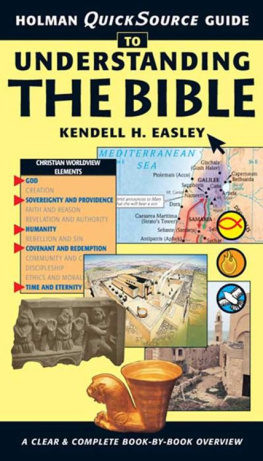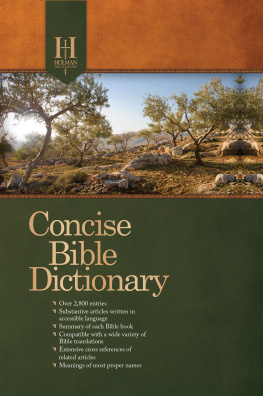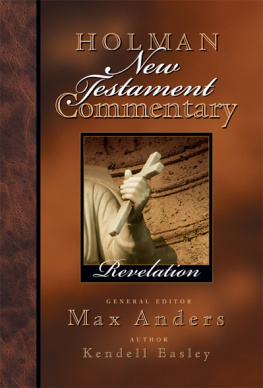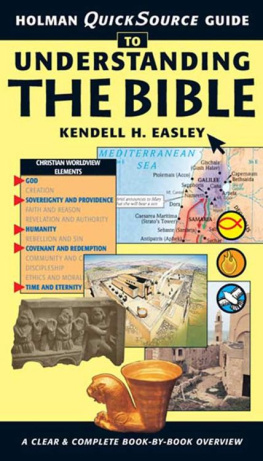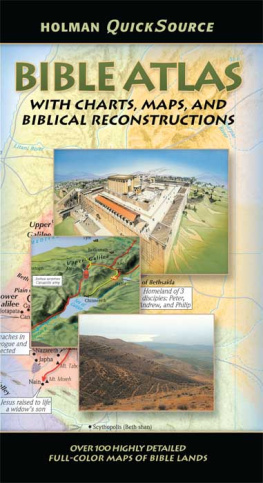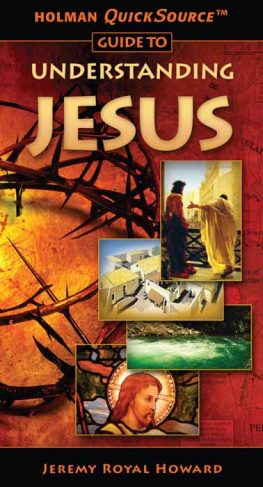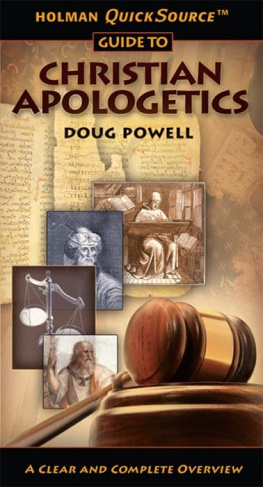Kendell H. Easley - Holman Quicksource Guide to Understanding the Bible
Here you can read online Kendell H. Easley - Holman Quicksource Guide to Understanding the Bible full text of the book (entire story) in english for free. Download pdf and epub, get meaning, cover and reviews about this ebook. year: 0, genre: Religion. Description of the work, (preface) as well as reviews are available. Best literature library LitArk.com created for fans of good reading and offers a wide selection of genres:
Romance novel
Science fiction
Adventure
Detective
Science
History
Home and family
Prose
Art
Politics
Computer
Non-fiction
Religion
Business
Children
Humor
Choose a favorite category and find really read worthwhile books. Enjoy immersion in the world of imagination, feel the emotions of the characters or learn something new for yourself, make an fascinating discovery.
- Book:Holman Quicksource Guide to Understanding the Bible
- Author:
- Genre:
- Year:0
- Rating:5 / 5
- Favourites:Add to favourites
- Your mark:
- 100
- 1
- 2
- 3
- 4
- 5
Holman Quicksource Guide to Understanding the Bible: summary, description and annotation
We offer to read an annotation, description, summary or preface (depends on what the author of the book "Holman Quicksource Guide to Understanding the Bible" wrote himself). If you haven't found the necessary information about the book — write in the comments, we will try to find it.
Holman Quicksource Guide to Understanding the Bible — read online for free the complete book (whole text) full work
Below is the text of the book, divided by pages. System saving the place of the last page read, allows you to conveniently read the book "Holman Quicksource Guide to Understanding the Bible" online for free, without having to search again every time where you left off. Put a bookmark, and you can go to the page where you finished reading at any time.
Font size:
Interval:
Bookmark:



INTRODUCTION
The Bible is both a bookthe world's best-selling bookand a library of sixty-six books. The impact of the Bible on Western Civilization is enough to spark anyone's curiosity about its content.
 | Victor Hugo, author of Les Miserables , observed, England has two books, the Bible and Shakespeare. England made Shakespeare, but the Bible made England. |
 | Immanuel Kant, one of the world's most influential philosophers, said, The Bible is the greatest benefit which the human race has ever experienced.A single line in the Bible has consoled me more than all the books I ever read besides. |
 | President John Quincy Adams treated the Bible as the key education resource in the lives of his children: So great is my veneration for the Bible that the earlier my children begin to read it, the more confident will be my hope that they will prove useful citizens to their country and respectable members of society. |
A number of years ago 1,200 university presidents and 1,000 CEOs were asked to name the book that had most affected their lives. The Bible was by far the most influential book in this survey of leaders. One in four listed the Bible as the most important book in their lives. The second book on the listCharles Dickens' A Tale of Two Cities was named as the most influential book by one in twenty-five.
In their classic, How to Read a Book , Mortimer Adler and Charles Van Doren noted, It would be true to say that, in the European tradition at least, the Bible is the book in more sense than one. It has been not only the most widely read, but also the most carefully read, book of all.
The Holman QuickSource Guide to Understanding the Bible is designed for those just beginning their study of this amazing book. The Bible is daunting just because of its size. More than that, it was written in times and cultures very different from our own. We are all like the Ethiopian treasurer, riding along in his chariot reading the prophet Isaiah. Philip approached him and asked, Do you understand what you're reading? He replied, How can I unless someone guides me? (Acts 8:3031 HCSB).
This QuickSource Guide walks with you through the Biblebook by bookand provides a concise overview of each book beginning with
- Key Bible Text: a verse that gives a clue to the meaning of the book
- Key Term: summarizes the book in one word
- One-Sentence Summary: shows how this particular book relates to God's Story. Fuller explanation of this summary is found in the section GOD'S STORY .
The QuickSource Guide then looks at how that particular book of the Bible contributes to and shapes a Christian's Worldview. Twelve themes that make up a Christian Worldview are as follows:
God; creation; sovereignty and providence; faith and reason; revelation and authority; humanity; rebellion and sin; covenant and redemption; community and church; discipleship; ethics and morality; and time and eternity.
GOD
CREATION
SOVEREIGNTY AND PROVIDENCE
FAITH AND REASON
REVELATION AND AUTHORITY
HUMANITY
REBELLION AND SIN
COVENANT AND REDEMPTION
COMMUNITY AND CHURCH
DISCIPLESHIP
ETHICS AND MORALITY
TIME AND ETERNITY
For each book, the QuickSource Guide indicates which of those themes are present in significant ways. It then addresses the questions of Author and Date of Writing, First Audience and Destination , and the Occasion that prompted its being written.
The sixty-six books of the Bible are made up of numerous genres. Knowing the type of literature of a particular text is an important step in interpreting the Bible. The QuickSource Guide addresses the Literary Genres of each book.
The great reformer, Martin Luther, found Christ in the Scriptures, first in Romans and then in the Psalms. As a result he came to the view that the center of all Scripture is Christ. The Scriptures begin very gently, and lead us on to Christ as a man, and then to one who is Lord over all creatures, and after that to one who is God. So do I enter delightfully and learn to know God. Following Luther's cue, each chapter in the QuickSource Guide has a feature called:
CHRIST IN
While the Holman QuickSource Guide for Understanding the Bible is designed for those who are just beginning their journey with the Bible, it will serve well those who have considerable experience with this book. Pastors and experienced Bible teachers will be acquainted with much of the material in this book, but the way the material is configured may provide new perspectives as they teach and preach.
At the beginning of our journey with the Bible, it's helpful to summarize, to compress a lot of information into some bite-size statements. In fact, we can summarize the entire Bible in the following sentence:
The Lord God through his Christ
is graciously building a kingdom of redeemed people
for their joy and for his own glory.
Notice that there is one subject (the Lord God it's his story) and one agent (Christ the one actively bringing about God's story). There is one major activity (building a kingdom , the main theme of Scripture) and one object of that activity (redeemed people , the center of God's mighty acts in both Testaments). There are also specific goals for God's story (their joy the human goal; his own glory the ultimate divine end for everything). When we keep this central truth before us, everything in Scripture falls into place as a development of this single concept. This is not just a story that you read about and put the book down. It's a story in which you are a participant. That's exciting!
Think of the biblical narrative as something like a modern novel. There is a prologue , giving background information that helps make sense of the plot. Then there is the plot development in a number of chapters. In the biblical narrative, the story develops in six chapters that take the account from beginning to culmination. Then finally at the end is an epilogue , telling what happens after the main story has ended.
PROLOGUE: THE NEED FOR REDEMPTION
(Genesis 111)
It all begins by explaining why the story must be told. God is building a kingdom of redeemed people because human beings are rebels who cannot save themselves. Other religions begin by assuming that people can do enough good works or perform enough religious deeds to earn a place in heaven. The Bible starts by telling the opposite story. Genesis 111 belongs to real human history, but the events are almost impossible to date. The main thing about the prologue is that it describes events involving the entire human race and shows that mankind has rebelled against God since the beginning.
CHAPTER 1: GOD BUILDS HIS NATION
Israel Chosen as the People of Promise, c. 2000931 B.C.
(Genesis 121, Kings 11)
The first chapter in God's plan to build an everlasting kingdom was to build an earthly nation in a particular time and place. This chapter carries the plot from the first family he called to his covenant (Abraham and Sarah) to the full splendor of the Israelite nation at its grandest expression (under David and Solomon).
Next pageFont size:
Interval:
Bookmark:
Similar books «Holman Quicksource Guide to Understanding the Bible»
Look at similar books to Holman Quicksource Guide to Understanding the Bible. We have selected literature similar in name and meaning in the hope of providing readers with more options to find new, interesting, not yet read works.
Discussion, reviews of the book Holman Quicksource Guide to Understanding the Bible and just readers' own opinions. Leave your comments, write what you think about the work, its meaning or the main characters. Specify what exactly you liked and what you didn't like, and why you think so.

